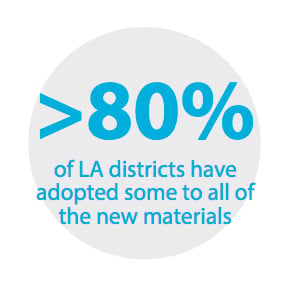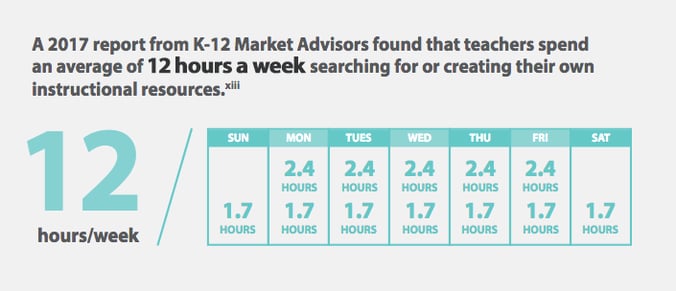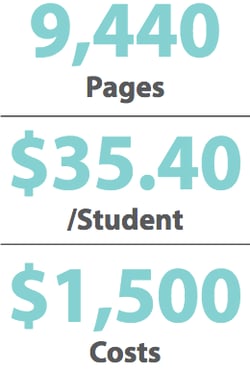Lessons Learned from Multiple Large-Scale Implementers
.jpeg?width=582&name=img-shelby-county-gradeschool-classroom%20(1).jpeg)
Custom materials and OER (Open Education Resources) solutions offer the promise of a richer, more personalized and flexible curriculum that will engage and improve student performance.
As a result, custom and OER solutions have attracted significant funding from the U.S. DOE,i foundations, statesii and school districts.
While there are many significant benefits, several common challenges continue to make these resources difficult to implement at scale, impeding the use of even the best designed custom and OER materials.
This white paper profiles multiple large-scale implementers of custom and OER resources. It summarizes four key lessons they learned and provides a roadmap for others to successfully implement custom curricula and open resources.
Unlike math and science, ELA and social studies standards typically require the use of authentic third-party content, such as complex texts including articles, essays, poems, text excerpts, primary source documents, etc. Frequently, this content remains protected under copyright, so copying beyond “fair use” requires permission from the copyright holder. Courts evaluate fair use claims on a case-by-case basis, and the outcome of any given case depends on a fact-specific inquiry. This means that there is no formula to ensure that a predetermined percentage or amount of a work—or specific number of words, lines, pages, copies—may be used without permissioniii. It is safe to say that when a district adopts a curriculum for thousands of students at scale, that material is far less likely to be considered fair use.
Unfortunately, many curriculum developers have either avoided copyrighted content altogether, ultimately reducing the quality of their curriculum, or they have pushed the question (and risks) of copyright permission downstream to the districts and teachers rather than create a solution that removes the risk of infringement or barriers to implementation.
One notable successful implementation of custom and OER curriculum is in the state of Louisiana. Frustrated with the historically struggling performance of its public schoolsiv the Louisiana Department of Education (LDOE) began a search for a well-rounded, standards-based ELA curriculum by turning to traditional textbook solutions. When they could not find a program that fit the specific needs of the state’s students, the LDOE decided to develop its own high-quality curricula that would provide teachers with the flexibility to tailor their lessons to the needs of their students, while ensuring alignment with Louisiana state standards.
To provide the necessary high-quality, complex texts that would support the new lesson plans, the LDOE selected copyrighted materials (e.g., text excerpts, short stories, poetry, articles, etc.).
In doing so, this created two significant questions for the LDOE:
Proceeding with this copyrighted content without a licensing and distribution solution would result in significant implementation barriers ranging from districts infringing copyright law to excluding critical elements of the curriculum.
‘Often, teachers feel like they should stick with the exact language in the textbook, but our open custom solution provides an opportunity to adapt [the material] and make it appropriate for the students in their classroom.’
Whitney Whealdon, Director of Academic Content, LDOE
 In order to create scalable solution for their districts, the LDOE partnered with XanEdu, a custom publisher centered on supporting K-12 customization and OER implementations, and together they created “Readers” from the copyrighted texts. XanEdu and its partner, Copyright Clearance Center (CCC), managed the permissions licensing as well as the editorial, design, and production and distribution process for the Readers. By packaging the copyrighted materials together, the LDOE created a straightforward, legally-compliant mechanism for districts to provide, that was unintimidating and easy for teachers to use, thereby removing previous implementation barriers.
In order to create scalable solution for their districts, the LDOE partnered with XanEdu, a custom publisher centered on supporting K-12 customization and OER implementations, and together they created “Readers” from the copyrighted texts. XanEdu and its partner, Copyright Clearance Center (CCC), managed the permissions licensing as well as the editorial, design, and production and distribution process for the Readers. By packaging the copyrighted materials together, the LDOE created a straightforward, legally-compliant mechanism for districts to provide, that was unintimidating and easy for teachers to use, thereby removing previous implementation barriers.
In addition to a having high-quality curriculum, this more affordable solution allowed the LDOE to access additional funding for aggressive professional development and implementation support. In 2015, Louisiana’s 4th graders showed the highest gains in reading scores of any state in the U.S., gains that have held steady since then.v

While access to devices continues to grow, for many teachers and students, serious technology challenges persist at schools and at home:
Indeed, a recent article in The New York Times reports a backlash from parents against screens in the classroom.viii Devices that students use for connecting with friends and playing video games need to magically become ‘learning devices only,’ and educators are required to enforce the rules.

Link rot is a serious problem. “It’s extraordinarily bad for the long-term maintenance of the information we need.” xi
Jonathan Zittrain, Professor of Law and Computer Science, Harvard University
Tennessee’s Shelby County Schools (SCS) was partway through a seven-year state adoption cycle, but needed more relevant, standards-based supplemental material better aligned to the demands of shifting literacy instruction. They decided to customize Louisiana’s open Guidebooks curriculum and considered both print and digital delivery options. With 65% of its student population being economically disadvantaged, access and equity were front of mind as they evaluated options for implementing their curriculum choice.
“Not only is the custom organization of the units more impactful for student achievement, but the strategies used to unpack a text or create a piece of writing have helped our teachers improve their practice.”
Shelby County Curriculum and Instruction Team
Like many districts, SCS has historically delivered many curriculum resources to teachers through online portals. For this custom solution, SCS determined the most equitable solution would be to have the Guidebooks Readers configured to meet their students’ and teachers’ unique needs allowing for maximum flexibility in the classroom and total equity. To SCS district leaders’ pleasant surprise, the book design and printed solution gave Shelby County’s curriculum team even more flexibility to meet the needs of their students, teachers and parents.
Washington DC’s central curriculum team collaborated with DC Public School (DCPS) teachers to co-develop their own custom curricula, “Passport to Learning” – the Primary (K-5) ELA curriculum – and “District Visions” – the Secondary (6-12) ELA curriculum – for DC Public Schools. DCPS needed a simple way to ensure every student would have access to the new content.
Delivering printed materials was fundamental to the solution and DCPS garnered grant funding to ensure all students have access to printed workbooks. “This year, access to print materials won’t be a barrier between students and engaging, rigorous texts,” said Corie Colgan, Interim Chief of Teaching and Learning. “That’s because we’ve partnered with XanEdu to collate, secure any required copyright permissions, reproduce materials, and deliver high-quality readers—and they did it all on a tight deadline.”
A printed custom book may seem like an ‘old’ technology, but it has fewer dependencies. Digital delivery requires a device, internet access, and digital fluency and understanding on the part of both students and teachers. For school districts with wide disparities in income and education, digital solutions can exacerbate inequality. Students and teachers are familiar with print and face few barriers to interacting with the format.
“Our curriculum was developed collaboratively by DC Public Schools’ curriculum team and teachers. It was built with equity, access, and social justice at its core,”
Corie Colgan, Interim Chief of Teaching and Learning.
Many large foundations have contributed to funding intended to help educators implement custom and OER solutions.xii As a result, states and districts have applied significant resources to help identify and curate lists of ‘quality’ materials. While these resources are abundant and useful, a lack of practical and efficient ways to locate and then use the materials in the classroom create enormous barriers for teachers to implement consistently at scale.

 Getting these resources into students’ hands usually means that teachers need to use a photocopy machine. More often than not, it’s the teacher who has to click on each link; hope that the link still functions, then head to the photocopy machine to print, collate and staple the materials. The cost in teachers’ time and the costs of delivering materials in this way are far greater than if they were to purchase the same materials from a commercial printer. In the case of the Louisiana 7th grade Guidebook, a teacher would need to duplicate nearly 9,440 pages for a 40-student classroom over the course of a year simply to provide the student handouts and worksheets specified in the curriculum. Assuming a not-unreasonable $0.15/page cost to duplicate (in paper, toner and teacher time), the annual cost is $35.40/student or a total cost per teacher of almost $1,500.
Getting these resources into students’ hands usually means that teachers need to use a photocopy machine. More often than not, it’s the teacher who has to click on each link; hope that the link still functions, then head to the photocopy machine to print, collate and staple the materials. The cost in teachers’ time and the costs of delivering materials in this way are far greater than if they were to purchase the same materials from a commercial printer. In the case of the Louisiana 7th grade Guidebook, a teacher would need to duplicate nearly 9,440 pages for a 40-student classroom over the course of a year simply to provide the student handouts and worksheets specified in the curriculum. Assuming a not-unreasonable $0.15/page cost to duplicate (in paper, toner and teacher time), the annual cost is $35.40/student or a total cost per teacher of almost $1,500.
Many teachers are required to pay for photocopy costs out of pocket, creating a major barrier to implementing with fidelity. For many districts as well as for individual teachers, the time and copy costs, (not to mention the needless frustration caused by paper jams and broken machines), required to reproduce thousands of pages of text can make free or low cost custom and OER resources far more difficult to implement than a traditional textbook.
According to Jenna Chiasson, Executive Director of Teaching and Learning at Jefferson Parish Public Schools, ‘Our teachers were spending too much time in front of the copy machine. And many times, parents raise concerns about curriculum due to a lack of visibility into online student resources. When parents can’t touch or easily see the materials, we tend to field more questions concerning educational quality and progress.’As Jefferson Parish implemented Louisiana’s Guidebooks ELA curriculum, they monitored teacher and parent feedback closely noting two key challenges:
The Jefferson Parish administration understood two key things:
Jefferson Parish worked with XanEdu to combine the online resources into a single comprehensive set of materials and to print and distribute it directly to the schools in the district at a fraction of the time and cost they would have incurred on copy machines. Teachers and parents gained flexibility and choice being able to access the materials in either online or hard copy format, ultimately improving parents’ ability to support their children at home.
“Teachers need time to prepare upcoming lessons to meet the needs of all students. Our goal is always to give teachers the high quality resources they need for themselves and students so they can focus on preparation and implementation in the classroom.”
Jenna Chiasson, Executive Director of Teaching and Learning
“By creating a high-quality printed book of the online resources, the experience for teachers and parents is elevated and becomes less intimidating, giving them confidence in the curriculum.”
Jenna Chiasson, Executive Director of Teaching and Learning
The notion of custom or OER curriculum often tends toward the utopian, the idea being that if teachers use open content and post it online for free, the result will be happier teachers and better-educated students. But in reality, even the best products aren’t used if they can’t be easily delivered.
Think Amazon.com – Schools and teachers want an easy and affordable implementation process similar to a single-click purchase on their Amazon app.XanEdu Guidebooks deliver a cost-effective, easy-to-use book to the classroom.
As more top-notch custom and OER curricula take hold across the country, education leaders will confront a new array of practical problems, including how these materials can be effectively distributed to schools within their own district or even to educators across the entire country.
As mentioned earlier, Louisiana’s Guidebooks curriculum was developed by the state and made available, not only to the schools in Louisiana, but to any school or educator interested in implementing the curriculum. Indeed, because the lessons are OER, schools and districts as far away as Ohio and Nevada have piloted pieces of the Louisiana curriculum with minimal investment and with the ability to adapt the curriculum to local students and conditions.
The state could not sell novels, books or the copyrighted readers to schools so Louisiana established multiple partnerships to ensure potential users of their curriculum would have easy access to the critical elements required to implement it successfully and with fidelity.
For now, all signs are that the Louisiana partnership model is working: A 2018 RAND study found that Louisiana ELA students were more apt to engage in practices aligned with the Common Core standards.xiv ‘We saw consistently higher results in Louisiana,’ Julia Kaufman, a RAND policy researcher, told EducationNext.
As Louisiana teacher Lesley Vines told Education Week, she, for one, is all in, despite her initial feelings of intimidation. ‘I think we’re on the right track,’ she said. ‘The growth in my students…was just tremendous.’xv
Scalable custom or OER implementations can be highly successful with the right planning and practical execution.
It is not enough to simply create and post high-quality custom or open materials. Despite the best of intentions, there are countless lesson plans and curricula available online that never get used in the classroom because of the aforementioned practical concerns and glitches. Ensuring the adoption and implementation of those materials in the classroom relies on planning practical access and distribution processes for the teacher, the student and even the parent. It is critical to reduce or address any dependencies up front – whether technical or practical—as these dependencies create significant—and often hidden—costs to using custom or OER materials.
Here’s a PDF version of this case study to print and share with others in your school district.
XanEdu’s K-12 CustomBook Solutions makes education personalized and affordable by giving districts and states control to create materials tailored to the unique needs of their students, rather than asking students to adapt to a standard, off-the-shelf resource. Working with more than 1,200 education institutions nationally, XanEdu helps learners at all levels of education access high-quality, student-centered, innovative learning resources.
Whitney Whealdon, Director of Academic Content, LDOE